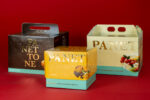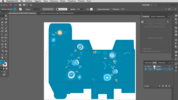Packaging design involves not only creativity but implies a series of rules. These rules are fundamental to communicate effectively with consumers.
We will shed light on packaging anatomy and break it down into its fundamental parts. Each part plays an important role you need to know to design effectively.
According to the Italian Packaging Institute “A well-studied packaging can stimulate the consumer by leading them either towards new desires, which the product will promise to satisfy or towards the search for reassurances, which brand recognition will provide. To guide the user towards the purchase, the packaging must, therefore, be original but recognizable, innovative but always practical, communicative but in a simple and clear manner.”
The main areas that make up the packaging structure and enable us to communicate effectively with consumers are the front, the back, and the sides.
Front
The front of the packaging performs some crucial functions. These are: attracting the consumer, facilitating the brand and product recognition, and quickly communicating uniqueness. This is the part of the packaging that gets the most spotlight and attracts the attention of the consumer. The front is also where the brand logo and the name of the product are displayed. While this area leaves plenty of room for creativity, it also subjects the designer to some unwritten rules such as the need to display the product’s distinctive elements.

Nestlé, a very health-conscious brand in terms of food, has placed a small nutritional label (top left) to show the consumer that its cereal is low in calories.
An image of a celebrity endorser well-known for her healthy lifestyle also plays a huge part in attracting consumers.
Back
The back of the packaging is reserved for information related to legal obligations such as the nutritional table for food products. This area might seem less interesting from a designer’s point. However, especially in recent years, the back of the packaging has become increasingly relevant. According to a survey conducted by Nestlé Observatory for Nutritional Habits, only 4% of Italian consumers do not read labels. Most of them are interested in knowing the ingredients and nutritional values of the food. Therefore, the back of the packaging has become a key vehicle for companies to relate to the consumer and build a lasting loyalty relationship.
Sides
Probably the least observed part of the packaging. The sides are the ideal placement for extra information such as suggestions or information of any type. References to the main social media often go here as a way of building a relationship between the consumer and the company. The packaging is no longer a mere container, but a powerful marketing tool.

An example of packaging that invites the consumer to engage with the company on social media.

A packaging that suggests alternative ways to consume food.
Conclusion
Creating a winning packaging is a mix of factors that involve many aspects beyond design. We hope this information will help you create packaging that is not only beautiful but also communicates to the consumer.













